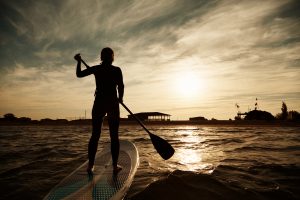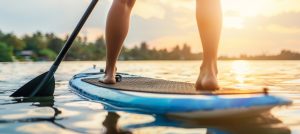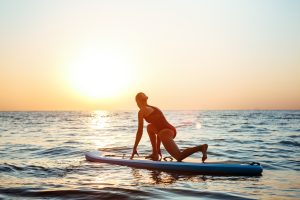Over the years, paddle surfing has become one of the most popular water sports worldwide.Today, 3.7 million people get on a board and start paddling the sea, no matter which continent they are on.
Its accessibility, its benefits and the fun it offers have been the ‘culprits’ for the growing number of people interested in the sport every year.So, if you’re thinking of taming the sea, this article will give you the best techniques to perfect your technique, whether you’re a beginner or an advanced paddler. Will you be able to keep your balance and paddle more effectively when you read what follows?
It all starts with correct posture
Posture is like the pillars that hold up a house, fundamental. When you get on the paddle surf board, that’s the first thing you have to take into account. Balance is up to you.
- Place feet shoulder-width apart.
- Slightly bend your knees
- Keep your back straight and your body relaxed.
- Look ahead instead of looking at your feet.
Rowing as an extension of your body
Rowing should be a part of you, you shouldn’t just row with your arms, you will only get tired faster and slow down. How can you and rowing be one?
- The hand at the top should grip the handle of the paddle, while the other hand holds the middle part.
- Keep the paddle as vertical as possible
- Instead of using only the arms, it incorporates the muscles of the torso and shoulders.
- Be sure to insert the paddle as far forward in the water as possible.
Entrenar dentro y fuera del agua
To progress in paddle surfing, it is also important to train out of the water. Exercises that strengthen your core, legs and arms will improve your stability, endurance and power.
To do this, practice:
- Yoga
- Pilates
- Strength training with weights or elastic bands
These can help you develop the muscles you need to paddle more efficiently.
Learn to tame the sea
Paddle surfing is a sport that connects you with nature, and an important part of improving your technique is learning to read the water.
Observe the waves, currents and wind before starting your session. Knowing how the water behaves will allow you to adapt your technique and avoid tricky situations.
- Paddle when there is current: Paddling against the current requires more energy, so it is advisable to start by paddling downstream if you plan a long session.
- Rowing into the wind: Squat slightly to reduce resistance and use greater torso rotation to propel the rowing.
Practice regularly: alone or with professionals
As with any sport, the key to improvement is consistent practice. Try to get out on the water often, even if it’s just short sessions.
If you already have paddle surfing experience and want to take your technique to the next level, it can be useful to take lessons with a professional instructor.
Every time you are on the board, you will have the opportunity to adjust details and gain confidence in your skills.







